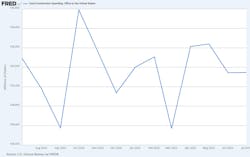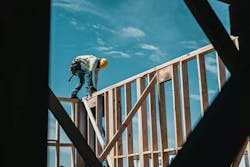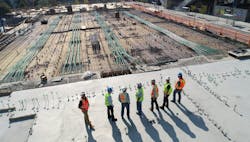Construction costs update: A closer look at spending, labor, and tariffs
This blog post was authored by Thad Berkes, Chief Cost Estimator, Design Collaborative.
Wow, what a roller coaster we’ve had over the past several months with tariff uncertainties. One thing we can count on, however, is the data that helps us understand what’s really happening in the market.
Construction Spending Trends
According to the Federal Reserve Economic Data (FRED) on Total Construction Spending in the United States, costs have started to level off, appearing to plateau for the time being. After years of volatility, this pause in fluctuation provides some welcome breathing room for project planning and budgeting.
Building Cost Index
The Turner Building Cost Index is showing a 4.19% year-over-year increase from 2024—slightly higher than last year’s 3.9%, but still more moderate compared to the dramatic shifts we saw earlier in the decade. For reference, between 2021 and 2022, the index jumped from 1.9% to 8%, reflecting the sharp inflation and supply chain disruptions of that period.
Historically, cost growth has averaged between 4% and 5% per year, with a dip to around 2% during the height of COVID and a surge back up to 8% in 2022. Seeing numbers stabilize in the 4% range is a promising sign for both owners and contractors—indicating that the market is normalizing after several unpredictable years. Stability is a welcome development across all aspects of construction.
Employment Conditions
According to the U.S. Bureau of Labor Statistics, the national unemployment rate is currently 4.3%, which is 0.2% higher than this time last year. While healthcare has seen employment gains, federal government jobs have declined. Construction employment, on the other hand, has remained relatively steady, showing little change from previous months.
For our industry, this steady employment rate supports ongoing project delivery and helps maintain the momentum we’ve seen across multiple sectors.
Tariffs and Material Costs
Material costs remain one of the most unpredictable variables in project estimating. Until more stable political and trade commitments are achieved, especially regarding U.S.–Canada trade relations, volatility in certain material categories will likely continue. This includes prices for steel, lumber, and aluminum. Hopefully, the coming months will bring greater clarity and balance in tariff policies.
A Steady Workforce
One thing we can continue to count on is the strength and resilience of the American construction workforce. Despite market swings, labor shortages, and global uncertainty, the people building our communities every day remain the foundation of our industry’s progress.
Overall, construction spending and costs appear to be stabilizing after several turbulent years. Moderate cost growth, steady employment, and early signs of price equilibrium suggest the industry is finding its footing again. While tariffs and global trade dynamics continue to pose challenges, the broader picture points toward a more predictable and balanced year ahead.
Closely monitoring these trends by tracking market data, material pricing, and labor conditions helps inform decisions and keeps construction projects on budget.
If you’re planning a new project or evaluating construction budgets for the year ahead, leverage our cost estimating services and the expertise of Design Collaborative’s Chief Cost Estimator, Thad Berkes.
About the Author
Design Collaborative
Design Collaborative is an award-winning multi-disciplinary design firm founded in 1992, with the belief that through our work, we can improve people's worlds. With nationally recognized expertise and a passion for improving worlds, DC has grown to become consistently ranked amongst the top 100 firms in the country by staying focused on designing people-first places. At DC, we provide boutique firm experience with big firm expertise and resources. Our team includes architects, engineers, interior designers, cost estimators, graphic designers, and support staff. We are a one-stop solution, providing real-time collaboration and problem-solving. Follow Design Collaborative on Facebook, Instagram, and LinkedIn.



